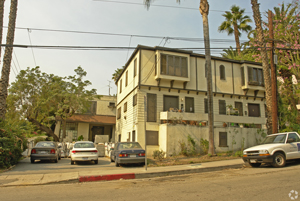
Brand new – and rent controlled.
Those have long been two separate things in L.A.’s real estate market, but now apartment buildings that fit both descriptions are starting to hit the market, and buyers need to be wary.
Last month, real estate investor Hillary Greene-Pae bought a new Hollywood apartment building from developer CIM Group – one she discovered is subject to the city’s rent-control laws well after negotiations had started.
“CIM was surprised,” she said. “Whatever team was working on this didn’t do their due diligence.”
The building is an oddity, but it’s not alone.
L.A.’s rent-control law, which limits rent increases that landlords can demand from tenants, usually applies only to buildings built before 1979. But there’s a catch, and a relatively new one: If you demolish rent-controlled apartments and build new ones on the same site within five years, those new apartments are also subject to the rent-control rules.
The Los Angeles City Council approved that change in 2007, but with a housing crash and financial crisis putting the brakes on development for several years, only now are new, rent-controlled units coming on the market.
“The law was adopted right as the market tanked,” said Anna Ortega, director of the rent stabilization division of the city’s Housing and Community Investment Department. “Only recently has it started to pick up.”
Ortega couldn’t say how many newly built buildings fall under the rent-control law, but the number is likely small. Tony Azzi, a senior vice president in the West L.A. office of Calabasas brokerage Marcus & Millichap, said he has seen a few new rent-controlled properties, though other brokers said CIM’s building was the first they’d seen.
“It’s a unique case – an outlier,” Kevin Kawaoka, a vice president in the West L.A. office of Encino brokerage NAI Capital, said of the former CIM property. “It’s very confusing that it’s a new rent-controlled property. When you see it’s a new property, your assumption is it’s non-rent-controlled.”
‘Hardest escrow’
That’s exactly the assumption Greene-Pae, a Calabasas psychotherapist, made when she started negotiations with CIM late last year to buy the 16-unit Orchid Apartments at 6900 W. Bonita Terrace, just north of Franklin Avenue in the heart of Hollywood.
Greene-Pae’s family real estate investment trust had sold some properties in Westchester and in North Carolina and she was looking for a 1031 exchange, which allows investors to defer capital-gains taxes if proceeds from one property go toward acquiring another of like value.
Greene-Pae, who invests on behalf of herself and her children, said she was specifically looking for a non-rent-controlled building. Because the building is new – it received its certificate of occupancy in October – she assumed it fit the bill.
But once negotiations started, Greene-Pae said she and her attorney discovered the rent-control issue and brought it to CIM’s attention.
“They didn’t know they had a rent-controlled building,” she said.
The discovery, by her account, led to lengthy negotiations and “the hardest escrow I’ve ever been through.”
She said she was willing to walk away from the building, but that CIM ultimately relented and accepted an offer of $7.6 million, down from the $8 million the developer had wanted.
“At that point, they didn’t want to start all over again,” she said. “They were tired.”
And while she was looking for a non-rent-controlled building, Greene-Pae said she’s not too worried about rents at the building. Rent-control rules limit rent hikes on existing tenants, but not on new ones. She’s able to charge market-rate rents today – averaging about $2,900 a unit a month – and doesn’t think the building will have too many long-term tenants.
“I’ve got students, I’ve got actors and actresses,” she said. “I have natural, organic turnover. If I were in a more stable area, I think (rent control) would be a bigger issue.”
CIM executives declined to comment beyond a brief statement that does not address the building’s rent-control status. Rather, it aims to explain why CIM built a new rent-controlled property in the first place.
“Given the demand by tenants and investors for multifamily properties in this strong market, rather than keeping the property vacant for five years, CIM developed a well-designed apartment building that complements and enhances this Hollywood neighborhood,” the statement says. “The property quickly leased at market rates, and was offered for sale to take advantage of the strong cap rates sellers could demand in this market.”
Kawaoka, the NAI broker, said it might simply have been a calculation by CIM that it is better to take advantage of today’s hot real estate market than to give up years of rental income and hope the boom continues for another few years.
“Rents have been growing pretty aggressively for a while, but it’s not going to be rent increases to infinity,” he said.
CIM might also have been looking to cut bait on the property, for which it might have had much bigger plans. The company bought three old properties on the Orchid site for about $2 million in April 2007. That was the same month the 10-acre site of Hollywood’s famed Yamashiro restaurant and Magic Castle went on the market.
The Orchid property borders the site, at the time thought to be a potential home for hundreds of condos or some other large development. CIM might have been interested in such a project, or it might have seen an opportunity to buy the Orchid site and flip it to whoever bought next door.
But the sale of the larger parcel was later tied up in court and canceled. After that, CIM in 2012 got demolition permits for the buildings on the Orchid site. The new apartments opened in 2014 – well within the city’s new five-year time limit.
Meanwhile, the Yamashiro site went back on the market this year, but not the section adjacent to the Orchid property.
